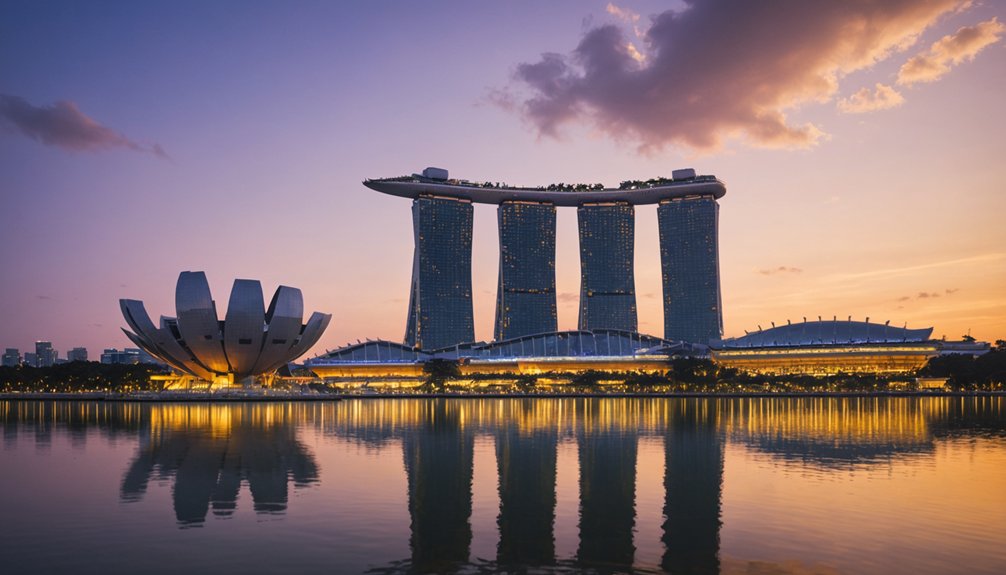For the most enjoyable Singapore experience, plan your visit between February and April when you’ll find ideal weather conditions with less rainfall and comfortable temperatures between 25-31°C. During these months, you can explore vibrant cultural celebrations like Chinese New Year while enjoying reduced crowd sizes and reasonable hotel rates. The shoulder season also offers great opportunities for both outdoor activities and cultural immersion. There’s much more to ponder when timing your Singapore adventure perfectly.
Key Takeaways
- February to April offers ideal weather with mild temperatures, low rainfall, and Chinese New Year celebrations.
- September to November provides 20-40% hotel discounts and smaller crowds during the off-peak season.
- December to January features festive Christmas and Lunar New Year events but expect heavy rainfall and peak tourist crowds.
- July to September brings comfortable temperatures for outdoor activities, though occasional haze from Southwest Monsoon is possible.
- May to June delivers warm temperatures perfect for water sports and activities before peak tourist season begins.
Peak Tourist Seasons in Singapore: What to Expect
While Singapore welcomes visitors year-round, certain periods transform the city-state into an especially vibrant hub of festivities and cultural celebrations. You’ll find the busiest seasons stretching from December to January, when Christmas festivities merge with Lunar New Year celebrations, and again from June to October during the Great Singapore Sale and National Day events.
These peak periods bring significant hotel pricing fluctuations, with rates jumping 30-50% above normal. You’ll also encounter transportation capacity challenges, particularly on MRT lines connecting major tourist destinations. During these times, attractions like Universal Studios and Marina Bay Sands see increased ticket prices and longer wait times. Visitors can expect warm humid weather throughout most of the peak season, with temperatures typically ranging between 25-32°C.
To navigate these busy periods effectively, you’ll want to plan ahead, especially for December visits, when hotel occupancy exceeds 85%. Consider exploring during shoulder months like February to April if you’re seeking a balance between festive energy and manageable crowds.
Weather Guide: Finding the Perfect Time for Your Visit
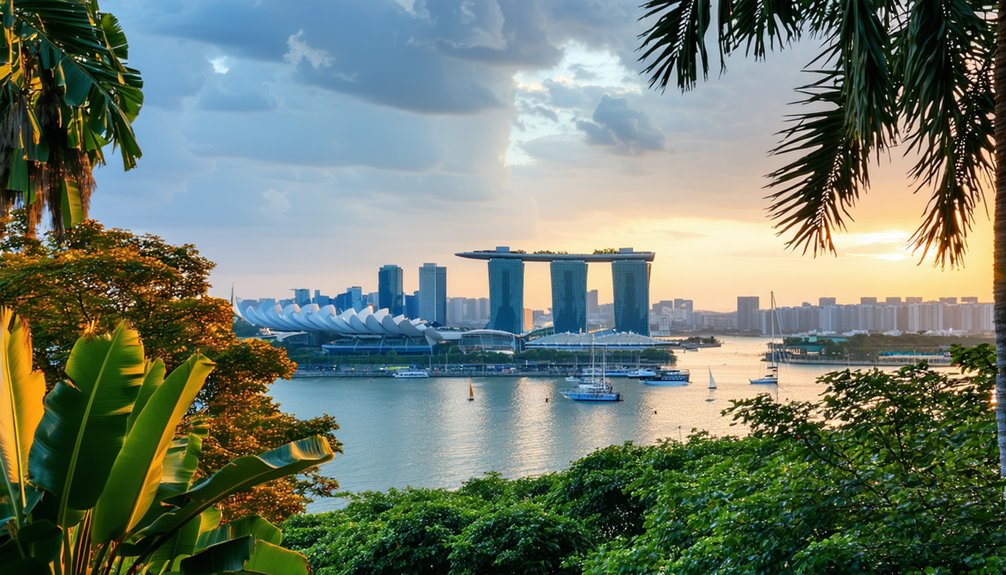
Situated near the equator, Singapore maintains a consistently tropical climate that shapes the visitor experience year-round. You’ll encounter temperatures between 25°C and 35°C, with high humidity levels hovering around 80-86% throughout the year.
For ideal packing requirements, focus on lightweight, breathable clothing and include a compact umbrella for unexpected afternoon showers. You’ll want UV-protective gear and SPF 50+ sunscreen, especially during the March-May peak heat period when UV indices exceed 11.
Outdoor activity planning is most favorable during October-April, when there’s less haze and milder winds. Schedule your adventures for mornings or evenings to avoid the intense midday heat. December brings the heaviest rainfall (287mm), while February offers the driest conditions (126mm) with six hours of daily sunshine. If you’re caught in the afternoon heat, you can always retreat to air-conditioned spaces like museums or MRT stations for a revitalizing break. The best travel window is between June and August, when temperatures stay comfortably between 24-31°C.
Monsoon Patterns and How They Impact Your Trip
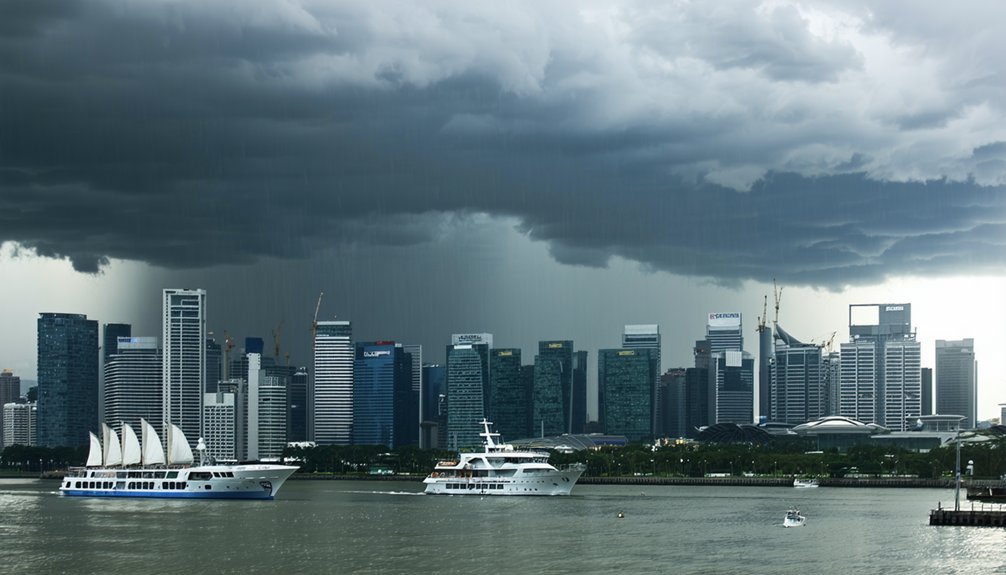
Singapore’s monsoon seasons shape your travel experience distinctly: the Northeast Monsoon (December-March) brings heavy rainfall and strong winds but includes a drier phase in February, while the Southwest Monsoon (June-September) features Sumatra squalls and potential haze issues. You’ll find the Northeast Monsoon’s wet phase challenges outdoor plans with flooding risks and flight disruptions, though its dry phase offers favorable conditions for exploring attractions. Recent monsoon rains in January 2025 led to 255.2mm total rainfall across just two days. Understanding these patterns helps you maximize your visit—consider October-April to avoid the Southwest Monsoon’s haze, or February-April for prime weather and post-holiday deals.
Northeast Vs Southwest Patterns
Understanding Singapore’s monsoon patterns is essential for planning your visit, as two distinct seasons shape the city-state’s weather throughout the year. The Northeast Monsoon, which dominates from December to March, brings considerable changes to your potential travel experience.
During this period, you’ll encounter two distinct phases. The wet phase (December-January) delivers moderate to heavy rains that can impact your sightseeing plans, requiring flexible scheduling and indoor alternatives. You’ll want to pack waterproof gear and plan activities accordingly. The dry phase (February-March) offers a welcome respite with minimal rainfall, making it more conducive to outdoor exploration. Despite seasonal temperature variations remaining relatively stable year-round, these monsoon patterns considerably influence when and how you’ll be able to experience Singapore’s outdoor attractions. When the monsoon subsides, you can enjoy foggy mornings clearing up to reveal perfect afternoon conditions for sightseeing.
Managing Rainier Travel Days
With monsoon patterns shaping Singapore’s weather, you’ll need smart strategies to navigate the rainier periods of your visit. During the wettest months (November-January), plan indoor activities between 12pm-4pm when thunderstorms typically peak. You’ll find refuge in the city’s extensive network of museums and malls, all accessible via sheltered transport options like the MRT system. Visitors can expect year-round tropical weather with consistent temperatures throughout their stay.
For wet weather packing tips, prioritize quick-dry clothing and waterproof footwear to combat the 80% humidity. A compact umbrella is essential, especially during morning Sumatra squalls that bring 50+ mph gusts. Track real-time weather alerts through the MSS Weather app, and maintain flexibility in your schedule – reserve mornings for outdoor attractions like Gardens by the Bay when rainfall is typically lighter.
Cultural Festivals and Events Worth Planning Around
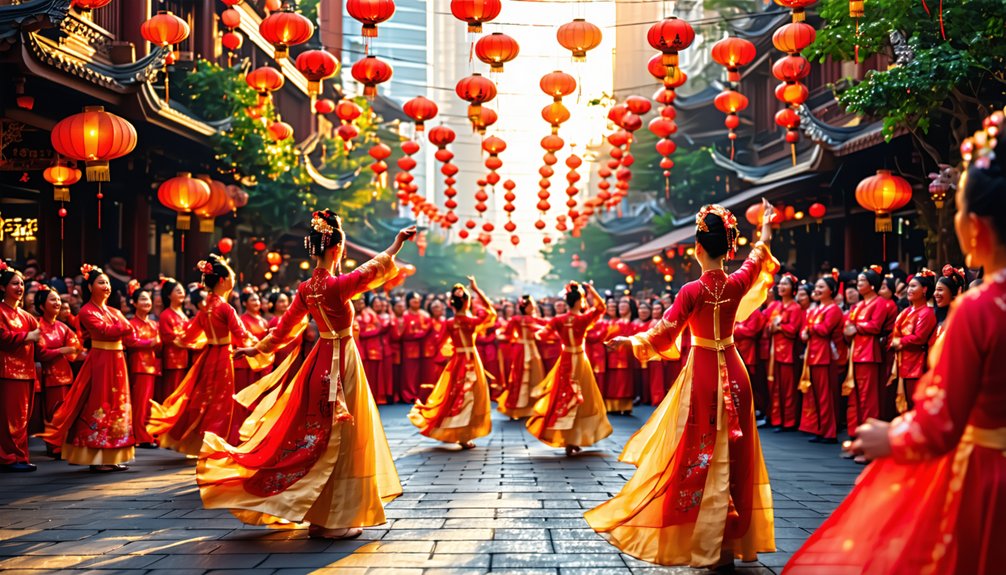
Singapore’s richest cultural experiences cluster around two peak festival periods: January-February’s harvest celebrations and July-September’s mid-year festivities. You’ll encounter vibrant neighborhood celebrations during Chinese New Year in Chinatown, Hari Raya festivities in Geylang Serai, and Pongal in Little India, where each ethnic precinct transforms with distinctive decorations and activities. These cultural festivals offer you authentic insights into Singapore’s multicultural heritage, from watching kavadi-bearers during Thaipusam to joining the Mid-Autumn Festival lantern displays at Gardens by the Bay. Many Buddhists commemorate Vesak Day by performing acts of kindness and charitable deeds to honor Buddha’s teachings.
Major Festival Peak Times
Throughout the year, you’ll find Singapore’s cultural calendar packed with vibrant festivals that showcase the city-state’s diverse heritage. One of the most anticipated events is the Singapore Food Festival, traditionally held in July, though recent schedules have shown flexibility with potential October dates. This iconic celebration of local cuisine lets you experience the rich tapestry of Singapore’s food culture through innovative events and traditional offerings. The Great Singapore Sale, one of the city’s biggest annual shopping events, draws significant crowds during June and July. When planning your visit around annual event scheduling, it’s worth noting that festival timing can shift between months, so it’s best to check the official tourism websites for the most current dates. This flexibility in scheduling allows you to experience Singapore’s cultural festivities while adapting your travel plans to catch these dynamic celebrations at their peak.
Cultural Neighborhood Celebrations
The vibrant cultural neighborhoods of Singapore come alive during annual festivities that transform entire districts into spectacular celebrations. One of the most enchanting displays occurs in Chinatown during Chinese New Year, when the entire district glows with themed lanterns and zodiac-inspired light installations from January through February.
You’ll find yourself immersed in a magical atmosphere as traditional lion dance performances weave through the streets, accompanied by the rhythmic beating of drums. The celebration transforms the neighborhood into a sensory feast, with vibrant street food stalls lining the walkways, offering seasonal delicacies and local favorites. The evening light-up creates perfect photo opportunities, as the illuminated decorations cast a warm glow over the historic shophouses and temples, making this cultural celebration a must-see experience during your Singapore visit. Families gather to enjoy traditional delicacies like yu sheng salad and barbecued pork during the festive period.
Smart Money-Saving Travel Periods
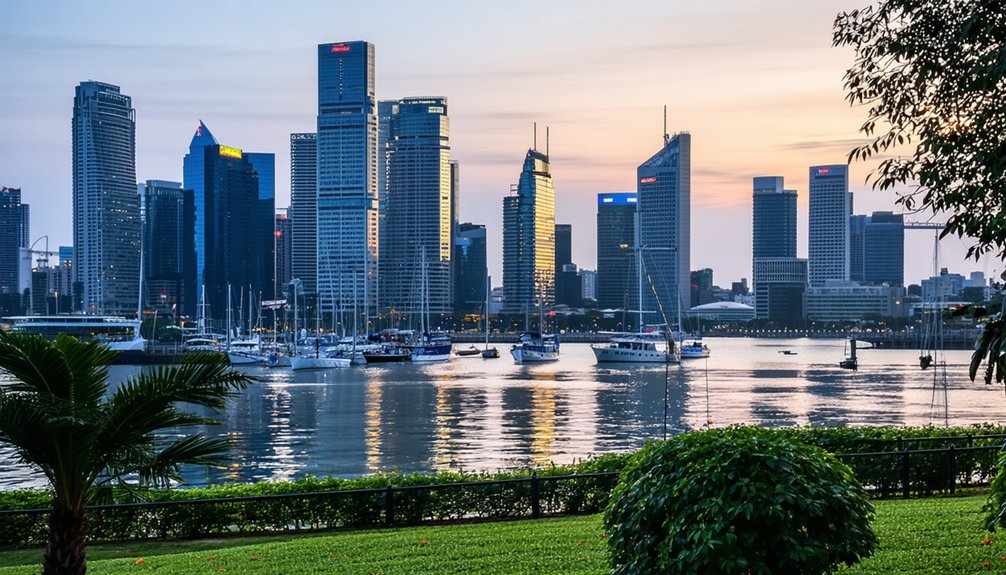
Planning your Singapore trip during money-saving periods can slash costs by up to 40% while still delivering an excellent experience. The off-peak months of September through November offer the deepest discounts on off season accommodation, with rates dropping 20-40% at most hotels. You’ll find shoulder season flights particularly attractive from February through April, when prices stabilize and the weather remains pleasantly dry. Shoulder season extends through May, offering continued savings for budget travelers.
Visit Singapore during off-peak September to November for major savings, with hotel rates slashed up to 40% and excellent weather conditions.
- September-November brings 30-40% fewer tourists and significant savings across attractions
- February-April offers ideal weather with reduced humidity and post-CNY hotel discounts
- June-August combines Great Singapore Sale savings with Sentosa Island promotions
To maximize your budget, consider visiting during the Southwest Monsoon period when crowds thin out and retail discounts peak. The sporadic rain showers won’t dampen your experience, especially with indoor attractions offering special rates. Just remember to avoid Deepavali week for the best deals and book Sentosa activities 2-3 weeks ahead.
Month-by-Month Travel Planning Guide
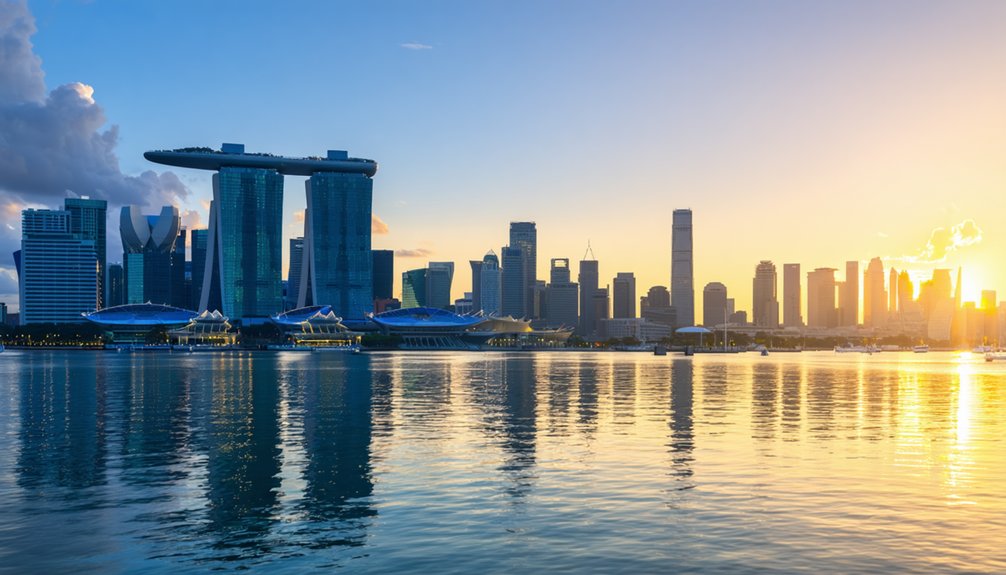
Singapore’s month-by-month climate patterns shape unique travel experiences throughout the year. You’ll find December through January brings heavy monsoon rains, making it perfect for exploring indoor attractions and catching festive Christmas displays at Gardens by the Bay. The average temperature typically ranges between 23 and 31 Celsius throughout the year. February to April offers ideal beach conditions with plenty of sunshine and manageable rainfall – perfect timing for Chinese New Year celebrations.
July through September presents suitable hiking weather, with the Southwest Monsoon bringing drier conditions ideal for outdoor adventures at MacRitchie Reservoir. You’ll encounter fewer crowds and better hotel deals during this period. May through June delivers warm temperatures excellent for water sports, though watch for potential haze. October and November usher in cultural festivals amid increasing rainfall.
Plan around these patterns for your preferred activities: February-April for beaches and festivals, July-September for nature trails, and December-January for festive events – just pack your umbrella.

